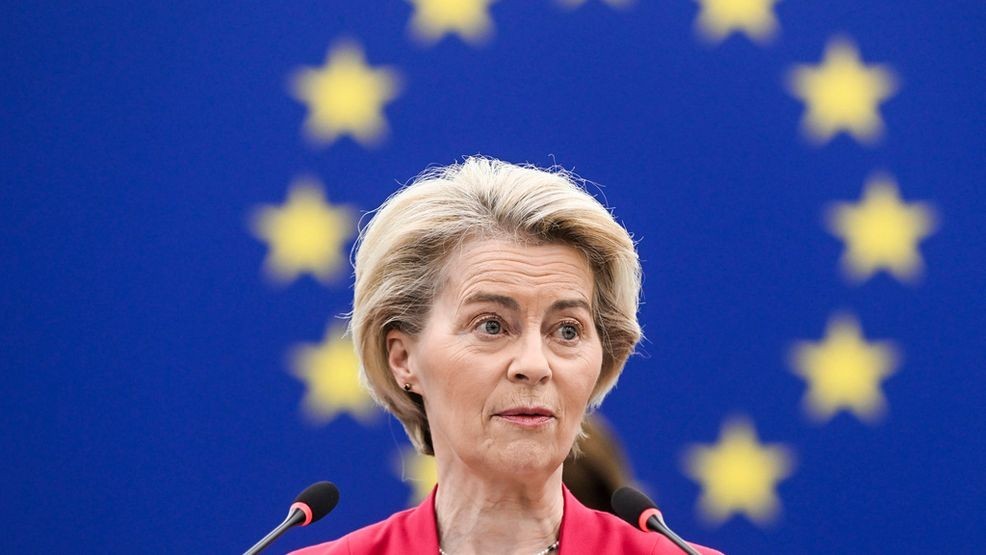WASHINGTON (TNND) — The European Union is trying to find an agreement to fend off a bruising trade war with its biggest economic partner but is increasingly preparing to take a hardball approach to dealing with President Donald Trump and his massive tariff regime.
Talks between U.S. and EU officials that have been happening for weeks are coming down to the closing stretch, with less than two weeks to avoid steep 30% tariffs on its exports if it can’t find an agreement with Trump.
The U.S. traded nearly $1 trillion worth of goods with the 27-nation bloc last year, by far its biggest relationship. But its continued trade partnership with the collective is up in the air as Trump is threatening 30% tariffs on its goods starting next month, an even steeper rate that was originally announced on April 2.
European officials have been saying they are hoping to reach a deal before the deadline but have also threatened to impose retaliatory tariffs on a wide range of American goods.
Commerce Secretary Howard Lutnick said on CBS’s “Face the Nation” on Sunday that he was confident a deal would be reached.
“These are the two biggest trading partners in the world talking to each other. We will get a deal done. I am confident we will get a deal done, OK? And it will be great for America because the president has the back of America,” Lutnick said. “All these key countries will figure out it is better to open their markets to the United States of America than to pay a significant tariff.”
He also said the upcoming deadline will not be delayed again. Trump initially set a 90-day deadline when he unveiled his “reciprocal tariffs” on April 2 that was extended to the beginning of August to give more time for talks.
“On Aug. 1, the new tariff rates will come in. But nothing stops countries from talking to us after Aug. 1, but they’re going to start paying the tariffs on Aug. 1,” Lutnick said on “Face the Nation.”
The administration had set an ambitious 90-day timeline to work out dozens of trade deals with all of its biggest trading partners from around the world that each have their own and conflicting priorities that made it a challenge to hammer out expansive trade agreements in such a short timeframe. Rather than dozens of deals, the U.S. has only agreed to a handful of agreements, some of which left the biggest issues mostly unresolved.
In addition to the complicated nature of multibillion-dollar trade deals, multiple countries have also run into issues knowing what to expect from the White House as the president has gone back and forth on policies, unveiled sector-specific tariffs in the middle of talks and seemingly sudden new demands for concessions.
Trump took European negotiators by surprise by pushing for higher baseline tariffs as negotiations hit the closing stretch, the Wall Street Journal reported. Trump also promised a 30% tariff on the EU in a series of letters sent to dozens of countries that he has described as what the terms of trade will be in absence of a broader deal.
The changing dynamics of the discussions have spurred some pessimism within the EU about coming to an agreement. Various European officials have said they are ready to take retaliatory measures and are being pushed to prepare new and more punishing measures to hit back against American companies.
“It’s hard to get agreements between 27 countries but it’s also the degree of exposure of different states to the tariff is not the same,” said Garret Martin, Hurst Senior Professorial Lecturer and the co-director of the Transatlantic Policy Center at American University. “Some countries are really feeling very vulnerable. The other consideration is basically the fear of taking a more hawkish line, what it will mean for all the other areas where there’s disputes, and in particular over Ukraine.”
Some officials have also supported using its “anticoercion” instrument as a pushback against Trump, which is a legal tool allowing the bloc to counter economic strong-arming with restrictions on trade and investment. It has never been used before and would be a significant escalation in a winding dynamic with Washington since Trump returned to office.
European Commission President Ursula von der Leyen said earlier this month that the anticoercion instrument was created for emergencies “and we are not there yet.” But if that conclusion were to change in the face of 30% baseline tariffs in addition to specific industry tariffs like cars and pharmaceuticals.
Germany has reportedly become increasingly pessimistic about finding a deal with the U.S. and become more open to taking a retaliatory approach.
“I don’t think we’re there quite yet in terms of the political wind. But Germany is a key player here because if Germany is feeling that they are getting a really terrible deal — and the French are already kind of keen to at least consider that sort of nuclear option — I think that would be the game-changer,” Martin said.
